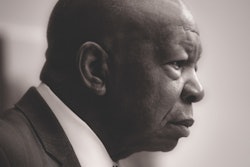On May 25, 2020, the killing of George Floyd by Minneapolis police officer Derek Chauvin sparked a national reckoning on racial injustice. The reverberations of that tragedy and the protests that followed reached every corner of American society, including the halls of higher education.
Colleges and universities across the nation, long seen as bastions of progressive thought and social change, found themselves thrust into the spotlight as students, faculty, and the public demanded concrete action to address systemic racism both on and off campus.
Now, four years after Floyd's death, this series examine the promises made by institutions of higher learning in the wake of that pivotal moment and assess the progress—or lack thereof—in addressing racial issues on campuses nationwide. This monthly series reveals a complex landscape of incremental changes, unfulfilled commitments, and ongoing challenges in the ongoing quest for racial equity in higher education.
In the summer of 2020, as protests swept across the country, college and university administrators rushed to issue statements condemning racism and pledging to take restorative action. These promises varied in scope and specificity, but some common themes emerged.
Many institutions, for example, vowed to increase diversity in their student bodies, faculty, and leadership. Administrators promised to revise curricula to include more diverse perspectives and address issues of race and equity. Pledges were made to improve campus climate and support for students of color and to invest in research and initiatives focused on racial justice. Some schools committed to reforming campus police practices and security policies, while others promised to shine a spotlight on their historical ties to slavery and racism.
In the immediate aftermath of Floyd's murder, the nation saw an unprecedented outpouring of commitments from higher education institutions. The real question was always going to be whether those promises would translate into sustained, meaningful action.
“The answer unfortunately has been no,” says Donte Mitchell, a student activist at the University of Michigan. “Progress has been slow. If anything, the nation has gone backward and, in many ways, the assault on Blacks in higher education has worsen.”
Initially, there had been some visible signs of progress. action. The University of Michigan, for example, launched its "Hiring for Diversity" program in 2021, which provides resources and training for search committees to combat bias in the hiring process. The program has been credited with a 30% increase in the hiring of faculty of color over three years.
Diversity in Numbers: Progress and Pitfalls
One of the most quantifiable areas of change has been in the composition of student bodies and faculty. Many institutions set ambitious goals for increasing the enrollment and retention of students of color, as well as hiring and promoting faculty from underrepresented groups.
Data from the National Center for Education Statistics shows that between 2020 and 2024, the percentage of Black students enrolled in degree-granting postsecondary institutions increased from 13% to 15%, while Hispanic student enrollment rose from 20% to 23%. However, these gains have not been uniformed across all types of institutions.
On the faculty front, progress has been slower. A 2023 study by the American Council on Education found that while the percentage of faculty of color increased slightly from 21% in 2020 to 24% in 2023, representation in tenured positions and leadership roles remained disproportionately low.
Critics argue that many institutions have relied too heavily on diversity statements and implicit bias training without addressing deeper structural issues. They point out that diversity initiatives that don't actively work to dismantle racist policies and practices are merely window dressing.
“We need to see institutions willing to fundamentally restructure their systems of power,” says Mitchell.
Curriculum Changes: Expanding Perspectives
In the wake of Floyd's death, many institutions pledged to revise their curricula to better reflect diverse experiences and perspectives. These efforts have taken various forms, from adding new courses on race and ethnicity to integrating discussions of racism and social justice into existing classes across disciplines.
At Amherst College, a new requirement was introduced in 2022 mandating that all students take at least one course focused on race and racism in the United States. Similarly, the California State University system implemented an ethnic studies requirement for all undergraduate students starting in the fall of 2023.
Scholars like diversity consultant Dr. Kenneth Parker, see these curricular changes as essential. “Education has the power to challenge long-held beliefs and biases,” he says. “By exposing students to diverse perspectives and the realities of systemic racism, we can hope to create more informed and empathetic citizens.”
However, these changes have not been without controversy. Some institutions have faced backlash from alumni, donors, and conservative groups who argue that such requirements amount to “indoctrination” or detract from traditional academic focuses. In several states, including Florida and Texas, legislation has been passed limiting how race can be discussed in public higher education settings, complicating efforts to expand race-focused curricula.
Campus Climate: The Lived Experience
Perhaps the most challenging area to assess has been the overall campus climate for students of color. Many institutions promised to create more inclusive environments and provide better support services for underrepresented students.
Surveys conducted by the Higher Education Research Institute at UCLA show a mixed picture. While a majority of students of color report feeling more supported by their institutions compared to 2020, incidents of racial discrimination and microaggressions remain frustratingly common.
Jasmine Thompson, a senior at Howard University and student activist, reflects on the changes she's observed. “There's definitely more awareness now," she says. “We see more events focused on diversity and inclusion, more resources available. But there's still this underlying tension, this feeling that we don't fully belong in these spaces that weren't originally designed for us."
Some institutions have made notable strides. Rutgers University-Newark, for example, launched its "Truth, Racial Healing & Transformation Campus Center" in 2021, which offers workshops, dialogue sessions, and community events aimed at fostering racial understanding and reconciliation. The program has been praised for its holistic approach to improving campus climate.
However, high-profile incidents of racism continue to make headlines. In 2023, a series of racist graffiti incidents at Syracuse University led to student protests and demands for greater accountability. The university's response, which included increased security measures and a review of its bias incident reporting system, was criticized by some students as inadequate.
In a number of interviews, scholars have repeatedly emphasized that improving campus climate isn't a one-time fix. It requires constant vigilance, regular assessment, and a willingness to listen to and act on student concerns.
Investment in Research and Initiatives
Many institutions promised to invest in research centers and initiatives focused on racial justice and equity. These commitments ranged from establishing new academic programs to funding community partnerships and outreach efforts.
One notable example is the University of California, Berkeley's $2.8 million investment in its "Initiative for Equity, Diversity, and Inclusion," launched in 2021. The initiative funds interdisciplinary research projects, community engagement programs, and graduate student fellowships focused on addressing racial inequities.
Similarly, Johns Hopkins University announced a $150 million investment in its “Racial Justice and Equity Initiative” in 2020, which includes funding for faculty hiring, student scholarships, and community partnerships in Baltimore.
The Dr. N. Joyce Payne Center for Social Justice (CSJ)—an initiative of the Thurgood Marshall College Fund—has been bringing together crucial voices and perspectives to positively impact Black life in American society in the aftermath of Floyd’s murder.
And its impact on social issues has been dramatic, say scholars who add that the need for a social justice think tank, particularly with a focus on historically Black colleges and universities (HBCUs), is critically important.
“The Payne Center sees the challenges as well as the opportunities that exist for the Black community as being complex, defying simple solutions, but requiring the synergistic intellectual capacity of thought leaders across multiple fields of endeavor,” says Dr. Fred A. Bonner II, the Wilhelmina Delco Endowed Chair in Educational Leadership and the executive director of the Minority Achievement, Creativity and High-Ability Center, Prairie View A&M University, and a collaborator with CSJ.
Dr. N. Joyce Payne is founder of the Thurgood Marshall College Fund (TMCF), the national advocacy organization designed to support students who attend the 47 publicly supported HBCUs. In 2021, TMCF launched the CSJ to advance social justice for Black Americans. Rooted in the African American community, CSJ has become a recognized research center integrally connected to HBCUs. It brings together scholars, thought leaders, and community advocates to identify, evaluate, and study pressing issues and develop sustainable means of change that will have a positive impact on Black life.
“We intend to harness our collective resources to not only engage scholars at HBCUs in the research of the center, but to channel that pedagogy to the full range of human needs of the Black community,” says Payne in an interview with Diverse.
CSJ has six primary areas of concentration: civic participation; economics and wealth; educational equity; the future of work; communities and environments; and organizational entities.
Those areas were developed through research and interviews with research scholars, thought leaders, and practitioners. “With this reservoir of information complemented by nearly 40 years of work at TMCF, we were able to define with clarity issues that disproportionately impact the ability of Black America and HBCUs to thrive,” says Payne.
Social injustice has been deeply embedded in policies and practices at every level of government and industry, says Dr. Harry L. Williams, president and CEO of TMCF. “Injustice literally costs lives and diminishes educational and economic opportunities for millions of African Americans and other members of historically marginalized populations,” says Williams.
Williams notes that, for more than a century, HBCUs have provided education for African Americans, bringing the world physicians, engineers, attorneys, inventors, politicians, and many other professions. They are hubs of innovation and upward mobility.
CSJ has six primary areas of concentration: civic participation; economics and wealth; educational equity; the future of work; communities and environments; and organizational entities.
Those areas were developed through research and interviews with research scholars, thought leaders, and practitioners. “With this reservoir of information complemented by nearly 40 years of work at TMCF, we were able to define with clarity issues that disproportionately impact the ability of Black America and HBCUs to thrive,” says Payne.
Social injustice has been deeply embedded in policies and practices at every level of government and industry, says Dr. Harry L. Williams, president and CEO of TMCF. “Injustice literally costs lives and diminishes educational and economic opportunities for millions of African Americans and other members of historically marginalized populations,” says Williams.
Williams notes that, for more than a century, HBCUs have provided education for African Americans, bringing the world physicians, engineers, attorneys, inventors, politicians, and many other professions. They are hubs of innovation and upward mobility.
Campus Police Reform: A Work in Progress
In the immediate aftermath of Floyd's death, many institutions faced calls to reform or even abolish campus police forces. Promises ranged from increased de-escalation training to complete reimagining of campus safety models.
The University of Minnesota made headlines in 2020 when it announced it would cut ties with the Minneapolis Police Department for large events. Other institutions, like the University of California, Berkeley, implemented new oversight committees for campus police and revised use-of-force policies.
However, progress in this area has been uneven. A 2023 survey by the Association of American Colleges and Universities found that while 78% of institutions reported implementing some form of police reform since 2020, only 23% had made significant structural changes to their campus safety models.
Scholars have long argued that campus police reform is not just about safety, but about creating an environment where all students feel truly welcome and protected. They argue that institutions have yet to fully grapple with the ways in which traditional policing models can perpetuate racial inequities.
Confronting Historical Legacies
One of the more complex challenges facing many institutions has been addressing their historical ties to slavery and racism. Promises in this area included everything from renaming buildings and removing statues to establishing reparations funds for descendants of enslaved people.
Georgetown University, which had previously acknowledged its history of slave ownership, announced in 2021 a $400,000 annual fund to benefit descendants of the enslaved people sold by the university in the 19th century. Similarly, Brown University expanded its "Fund for the Education of the Children of Providence" in 2022, which provides college scholarships to students in the local public school system, many of whom are from communities historically impacted by the slave trade.
However, these efforts have often been met with controversy and legal challenges. At the University of North Carolina at Chapel Hill, a plan to offer $2.5 million to a neo-Confederate group in exchange for not displaying Confederate flags on campus was met with widespread criticism and ultimately scrapped.
The Role of Student Activism
Throughout the past four years, student activists have played a crucial role in holding institutions accountable for their promises and pushing for further change. From sit-ins and protests to social media campaigns and formal presentations to boards of trustees, students have kept racial justice issues at the forefront of campus discussions.
James Morris, a graduate student at Emory University and organizer with the Black Student Alliance, reflects on the evolution of student activism since 2020. “There was this initial surge of energy and attention,” he recalls. "But as time went on, we had to find ways to sustain that momentum, to keep the pressure on even when the national spotlight faded."
Student-led initiatives have achieved notable successes. At Yale University, persistent student advocacy led to the creation of a new academic department focused on ethnicity, race, and migration in 2022. At the University of Missouri, student protests resulted in the implementation of a new bias reporting system and increased funding for mental health services for students of color.
However, some student activists, express frustration with the pace of change and what they see as performative actions by administrators. "We're tired of task forces and committees that don't lead to real action," says Aisha Rodriguez, an undergraduate at the University of Texas at Austin. "We need to see concrete policies and accountability measures."
Looking Ahead: Challenges and Opportunities
As we reflect on the four years since George Floyd's death, it's clear that while progress has been made in addressing racial issues on college campuses, significant challenges remain. Institutions continue to grapple with how to translate well-intentioned promises into lasting, structural change.
Several key challenges loom on the horizon:
· Sustaining momentum: As national attention has shifted to other issues, there's a risk of racial justice initiatives losing priority and funding.
· Political pushback: Increasing legislative efforts to restrict discussions of race and racism in educational settings pose a threat to many of the curricular and programmatic changes implemented since 2020.
· Economic pressures: With many institutions facing budget constraints, there are concerns about the long-term sustainability of new diversity initiatives and support services.
· Measuring impact: Developing meaningful metrics to assess the effectiveness of racial equity efforts remains a challenge for many institutions.
Despite these obstacles, there are also reasons for optimism. There has been an increased collaboration between institutions and community organizations. Moreover, the ongoing national conversation about racial justice has created new opportunities for research and innovation in higher education. The increased focus on racial equity has opened up new avenues for scholarship and practice, with a focus on areas like equity-minded pedagogy and culturally responsive student services that have the potential to transform higher education.
As colleges and universities continue to navigate the complex landscape of racial issues, it's clear that the promises made in the wake of Floyd's death were just the beginning of a long journey. The true test will be whether institutions can sustain their commitment to racial equity in the face of changing political winds, economic pressures, and competing priorities.
For many students, faculty, and administrators of color, the stakes couldn't be higher. As Jasmine Thompson, the Howard University student, puts it: "This isn't just about making campuses more diverse or inclusive. It's about creating institutions that truly value and empower all students, regardless of their race or background. We can't afford to let this moment pass without real, lasting change."
As we look to the future, the higher education community faces a critical choice: to retreat from the bold promises made in 2020 or to redouble efforts to create truly equitable and just institutions. The decisions made in the coming years will shape not just the future of higher education, but the future of racial justice in America as a whole.
This story was produced with support from the Education Writers Association Reporting Fellowship program. This is the first in an occasional series of stories published throughout 2024 by Diverse.















